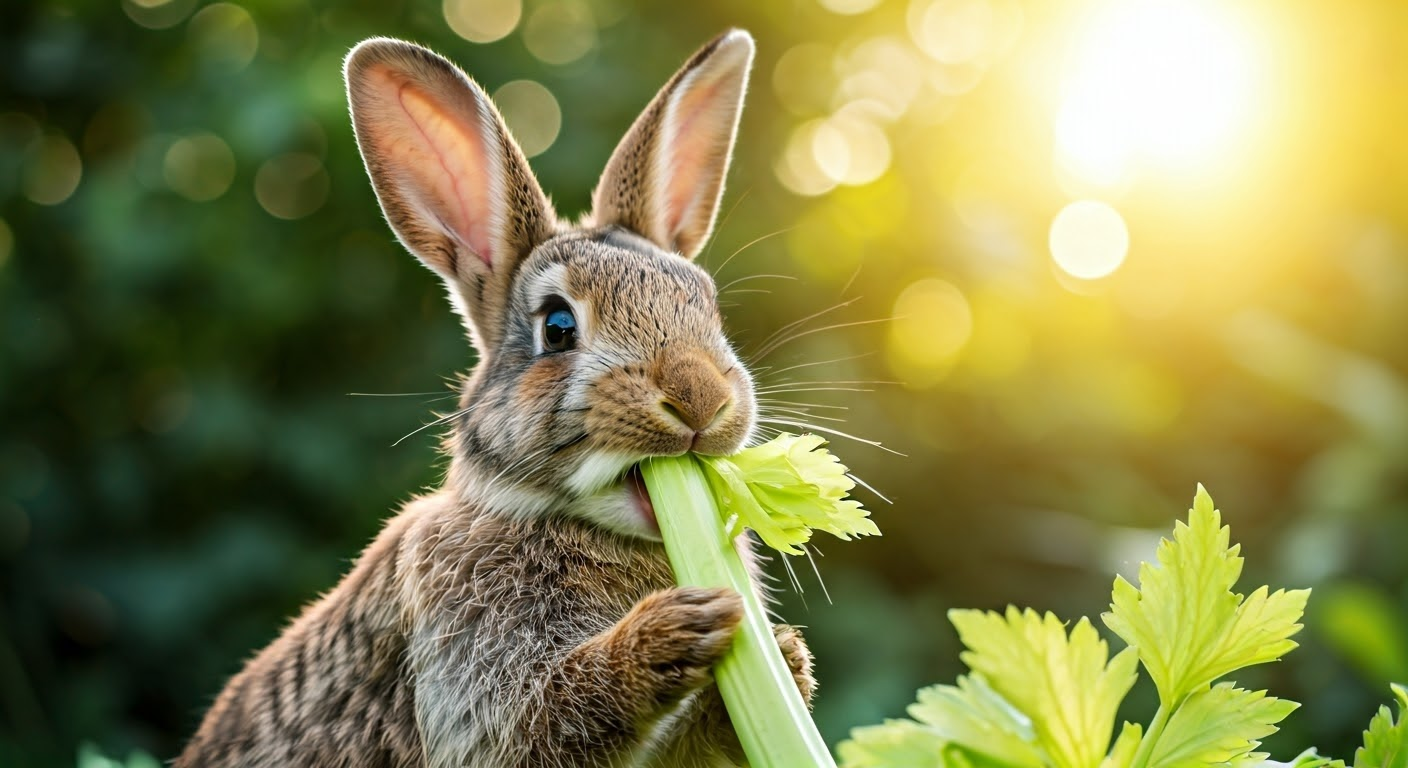Key Highlights
- Yes, rabbits can eat celery! It is good for them because it has a lot of water, vitamins like vitamin C, and fiber.
- Always wash celery and cut it into small pieces. This helps your rabbit eat it and prevents choking.
- Remember to use moderation! Too much celery can upset a rabbit’s stomach. It’s best to offer it as a treat or a part of a balanced diet.
- Introduce celery slowly into your rabbit’s diet. This way, you can watch for any digestion issues.
- Celery leaves are safe for rabbits too and have even more nutrients than the stalks.
Curious about how to keep your pet rabbit healthy with new foods? A balanced diet is very important for your rabbit’s digestive health. It helps their digestive system and affects their overall well-being and happiness. Also, talking to a veterinarian can give you helpful advice on what your rabbit needs to eat. Now, let’s answer this question: Can rabbits eat celery, and is it good for them?
Exploring the Benefits of Celery for Rabbits

Celery is a crunchy and fresh vegetable that many people enjoy, just like watercress. It can be a healthy food for your rabbit too. One great thing about celery is its high water content. But be careful; while celery is refreshing, eating too much can lead to too much sugar intake. It’s very important to keep rabbits hydrated. This is especially important during warmer months or if they don’t drink a lot.
Celery is good for rabbits because it provides important nutrients. It has vitamin C, which helps make a rabbit’s immune system stronger. It also contains folic acid, which is important for cell growth and development.
Nutritional Value of Celery
Celery is not just a vegetable with high water content. It also has many important vitamins and minerals. These help keep rabbits healthy and can prevent problems like obesity.
One important vitamin in celery is vitamin C. This vitamin helps keep cells safe and supports the immune system. While rabbits can produce some vitamin C on their own, adding foods like celery can help them have enough.
Celery is high in potassium. Potassium is an important electrolyte. It helps keep fluids balanced in the body. It also supports muscle function and helps nerve signals to work. For a rabbit’s health, getting enough potassium is really essential.
Hydration and Fiber: How Celery Supports Rabbit Health
Celery has a lot of water. This helps to keep rabbits hydrated. Staying hydrated is very good for their delicate digestion. A rabbit that gets enough water is less likely to face problems like constipation.
Celery is an important part of a rabbit’s diet because it has dietary fiber. This fiber is good for digestion. It makes their stool bigger and helps them use the bathroom regularly.
The fiber found in celery is good for a rabbit’s teeth. Rabbit teeth keep growing their whole life. Eating fibrous foods like celery can help prevent issues that happen when their teeth get too long.
Safe Serving Sizes and Frequency
Celery is healthy for rabbits, but you should only give it in small amounts. You can also add carrot tops, beet greens, herbs like basil, pears, and brussels sprouts to their diet. Always chop the celery into small pieces. This way, you can help prevent choking and make it easier for your rabbit to eat.
The amount of celery you can give your rabbit depends on its size, weight, and diet needs. Celery is best as a special treat or as part of a balanced diet.
How Much Celery Can Rabbits Eat?
To find out how much celery is safe for your rabbit, think about their body weight. Here’s a simple guide for serving celery safely:
|
Rabbit Weight |
Safe Celery Serving |
|
Under 2 pounds |
1-2 small sticks |
|
2-4 pounds |
2-3 small sticks |
|
4-6 pounds |
3-4 small sticks |
|
Over 6 pounds |
4-5 small sticks |
Remember, these are just rough guidelines. It’s very important to watch your rabbit after you feed them celery. Look for any signs of stomach upset.
Frequency of Feeding Celery to Rabbits
The amount of celery you give to your bunnies depends on their digestive system. Some bunnies can eat celery more often than others.
- Begin by giving your rabbit celery as a special treat.
- Do this about two times a week.
- Watch your rabbit closely after they eat celery.
- Look for any signs of stomach issues, like soft stools or diarrhea.
If you notice any problems, reduce the celery treats for your rabbit. If your rabbit handles the celery well, you can gradually give more treats a few times each week.
Preparing Celery for Your Rabbit

It is important to prepare celery the right way before giving it to your rabbit. First, wash the celery thoroughly under running water. This will help remove dirt, bits, and any chemicals that might be on it.
Then, cut the celery into small pieces. Make sure the pieces are no larger than your rabbit’s nail. Cutting the celery into small pieces helps your rabbit chew it easily. It also makes it easier for them to digest. This way, you can reduce the chance of choking.
Washing and Cutting Celery the Right Way
When you clean celery for your rabbit, use fresh, cool running water. Lightly rub the outside to remove dirt or anything else. If you are concerned about pesticides, consider getting organic celery.
After you wash the celery, cut it into small pieces. Aim for pieces that are about 1/2 inch to 1 inch long. Small pieces are good for rabbits. They find it easier to chew and digest. This also reduces the risk of choking.
If you are giving celery to your rabbit for the first time, start with a small piece. This will help you watch how their digestive system responds.
To Peel or Not to Peel: Best Practices
When you prepare celery for your rabbit, you may wonder if you should peel the stalks. The good news is that both the celery leaves and stalks are safe and healthy for rabbits to eat.
The leaves are better for your rabbit because they have more nutrients than the stalks. So, don’t throw the leaves away! You can feed your rabbit both leaves and stalks.
Peeling celery stalks is not necessary. However, some rabbits may not enjoy the strings in the stalks. If your rabbit struggles with these strings or if they get stuck in their teeth, it is nice to peel them.
Conclusion
In conclusion, celery and escarole can be a good part of your rabbit’s diet if you give them in small amounts. High-fiber timothy hay pellets help keep your rabbit hydrated and provide important fiber for their health. Be sure to wash and prepare the celery well before you feed it to your rabbit. You can also give berries and other fruits, but do this in moderation because they have high sugar content. Watch how much they eat and add new foods slowly. If you have more questions about rabbit nutrition or care, check our FAQ section for more information. Your rabbit’s health is very important, so make good choices about their food.
Frequently Asked Questions
Can rabbits eat celery leaves and stalks?
Yes, rabbits and baby rabbits can eat the leaves and stalks of the celery plant. They can also enjoy fresh leafy greens like spinach and broccoli. Both parts are safe and healthy. However, it is important to give these foods in moderation. Start by adding celery, spinach, and broccoli slowly to your rabbit’s diet. Make sure to give them in small quantities at first.
What other vegetables are safe for rabbits?
A mix of leafy greens is great for rabbits. Safe options include bok choy, romaine lettuce, cilantro, parsley, and mustard greens. Make sure to introduce new vegetables slowly.
How do I introduce celery into my rabbit’s diet?
When you add celery or any new vegetable to your rabbit’s diet, start with a tiny piece. Give it in small amounts. This will help you see how they handle the new food. If they have no stomach issues, you can slowly give them more over time.

Hi, I’m Sondip,
I’m a writer who loves to help people solve their problems. I write about small animals like mice and other small animals and even pests.

